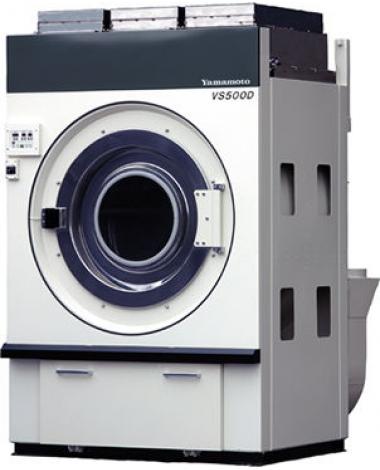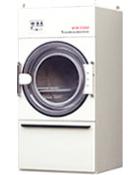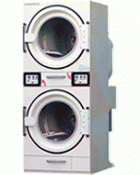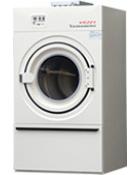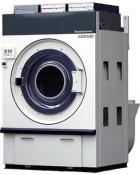Yamamoto measure the capacity of their tumble dryers in DRY Weight the same as your washers - so if you have a 25KG washer a Yamamoto 25KG tumble dryer will match that machine. Other M/F use WET Weight for tumble dryer capacity, this IS CONFUSING and means that you or someone else has to work out the weight of your linen after extraction to correctly match up tumble dryer size .
So Yamamoto make it easy for us by calculating dry weight capacities for their range of tumble dryers - SO EASY !!
Periodic machine maintenance tasks may be completed by any competent tradesman..
Your staff will love the user friendly controls and selection of drying cycles.
COMMERCIAL TUMBLE DRYERS
In the world of laundry, commercial tumble dryers serve as an industrial-grade solution for businesses requiring a sophisticated and efficient approach to drying laundry. Tailored for high-capacity use in commercial settings like laundromats, hotels, and hospitals, these robust appliances are purpose-built to meet the demands of regular processing of substantial volumes of laundry.
What sets them apart from their domestic counterparts is their heightened capacity, durability, and ability to withstand continuous usage, making them pivotal components in establishments where laundry efficiency is critical.
At the heart of a commercial tumble-drying functionality, is its innovative drum design, which facilitates the expeditious drying of laundry. The drum rotates, causing the laundry to tumble, promoting optimal exposure to heat and airflow. This dynamic combination ensures swift and effective drying, a stark contrast to the slower and less robust capabilities of household tumble dryers.
The engineering precision behind commercial tumble dryers is geared towards enhancing productivity, minimizing downtime, and providing a reliable solution for businesses grappling with the constant demand for timely laundry services.
TYPES OF COMMERCIAL TUMBLE DRYER
There are different types of commercial tumble dryers. They include the following:
Vented Tumble Dryers:
Vented tumble dryers expel moist air through a vent, typically installed through a wall or window. These dryers are suitable for spaces with proper ventilation and are known for their energy efficiency and reasonable drying times.
Condenser Tumble Dryers:
Condenser tumble dryers, on the other hand, do not require external ventilation. They utilize a condensing system to extract moisture from the air, collecting it in a container that needs to be emptied periodically. This enhances their versatility for installation, plus they use less energy than vented dryers, as well as being faster to dry garments.
Heat Pump Tumble Dryers:
Heat pump tumble dryers are the most energy-efficient among commercial options. They reuse heat generated during the drying process, making them environmentally friendly and massively cost-effective over the long term. These are the latest in modern laundry appliances.
DIFFERENCE BETWEEN COMMERCIAL AND INDUSTRIAL TUMBLE DRYERS
The primary difference between commercial and industrial tumble dryers lies in their scale and intended usage. Commercial tumble dryers cater to businesses with substantial but not overwhelmingly large laundry needs. These dryers are characterized by their efficiency and durability, making them suitable for establishments like hotels, spas, or mid-sized laundry facilities. They provide reliable performance for moderate to high laundry demands, ensuring swift and effective drying processes.
In contrast, industrial tumble dryers are engineered to meet the demands of the most intensive laundry environments. These machines find their place in large-scale operations such as textile factories, processing massive volumes of laundry continuously. Industrial tumble dryers are built with robust construction to withstand heavy and constant usage. Additionally, they often incorporate advanced features and technologies, contributing to their enhanced performance, super-efficiency, and resilience in handling the rigorous demands of industrial-scale laundry operations.
INDUSTRIAL GAS FIRED TUMBLE DRYERS
Gas fired tumble dryers share similarities in their reliance on gas as a heating source, yet they differ in scale, capacity, and intended use.
An industrial gas tumble dryer is designed for super-sized operations that demand robust and high-capacity drying solutions. This machine uses gas-powered burners to generate the heat needed for the drying process. Large-scale hospitality facilities are a very popular choice for these machines. The emphasis on rapid heating contributes to shorter drying cycles, enhancing overall productivity. They offer a cost-effective alternative, especially in facilities where natural gas is readily available.
On the other hand, the commercial gas tumble dryer is tailored for smaller to moderate-sized businesses with laundry requirements that are substantial but not on an industrial scale. This dryer also employs gas-powered burners to generate heat, but their design and capacity are more suited for settings like small hotels, bed and breakfasts, or mid-sized laundromats.
Commercial gas tumble dryers strike a balance between efficiency and capacity, addressing the needs of businesses that fall between domestic and industrial scales. While they share the cost-effectiveness of using gas as the heating source, their specifications are more aligned with the demands of smaller businesses where non-stop, heavy-duty usage is not the primary consideration. Overall, the key distinction lies in the scale and intended use for what you choose.
TAKING CARE OF AN INDUSTRIAL TUMBLE DRYER MACHINE
Maintaining an industrial tumble dryer machine is crucial to preserving its longevity and ensuring consistent, optimal performance. A comprehensive care routine involves several key practices that address various components and potential issues.
Regular cleaning is foundational to keeping an industrial tumble dryer in top condition. Lint traps, filters, and exhaust ducts must be cleaned at regular intervals to prevent the build-up of lint and debris. Accumulated lint not only hampers airflow, diminishing drying efficiency, but it also poses a significant fire hazard. Making a cleaning schedule is paramount for the safety and functionality of the machine.
Routine inspection of critical components is equally important. Belts, bearings, and other moving parts should be periodically checked for signs of wear or damage. Prompt replacement of any worn-out components is essential to prevent more extensive damage and to ensure smooth operation. This proactive approach to maintenance contributes significantly to preventing unexpected breakdowns and costly repairs.
A thorough ventilation check is another integral aspect of industrial tumble dryer maintenance. A well-maintained ventilation system facilitates efficient drying by ensuring proper airflow and prevents the dryer from overheating. Adequate ventilation is essential not only for performance but also for the safety of the equipment and the surrounding environment.
For gas tumble dryers, an additional layer of care involves scheduling regular inspections of the gas system by qualified technicians. This includes checking for leaks, ensuring proper combustion, and verifying that safety features are in optimal condition. Given the potential risks associated with gas systems, this step is crucial for both the functionality and safety of the premises.
Lastly, scheduling professional servicing at regular intervals is imperative. While routine maintenance checks can address visible issues, professional servicing goes a step further. Qualified technicians can delve into more complex aspects of the machine, lubricate moving parts, and conduct in-depth inspections that may not be feasible during regular maintenance checks. Professional servicing adds an extra layer of assurance that the industrial tumble dryer is operating at its peak and minimizes the risk of unexpected malfunctions or downtime.
